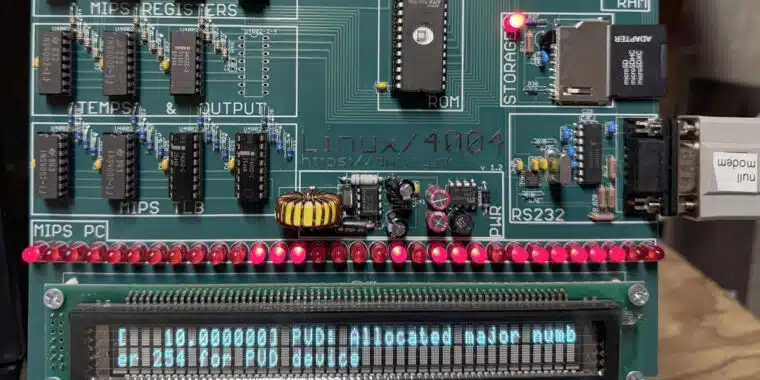If you experience any difficulty in accessing content on our website, please contact us at 1-866-333-8917 or email us at support@chicagovps.net and we will make every effort to assist you.

– Sep 23, 2024 6:48 pm UTC
Hardware hacker Dmitry Grinberg recently achieved what might sound impossible: booting Linux on the Intel 4004, the world’s first commercial microprocessor. With just 2,300 transistors and an original clock speed of 740 kHz, the 1971 CPU is incredibly primitive by modern standards. And it’s slow—it takes about 4.76 days for the Linux kernel to boot.
Initially designed for a Japanese calculator called the Busicom 141-PF, the 4-bit 4004 found limited use in commercial products of the 1970s before being superseded by more powerful Intel chips, such as the 8008 and 8080 that powered early personal computers—and then the 8086 and 8088 that launched the IBM PC era.
If you’re skeptical that this feat is possible with a raw 4004, you’re right: The 4004 itself is far too limited to run Linux directly. Instead, Grinberg created a solution that is equally impressive: an emulator that runs on the 4004 and emulates a MIPS R3000 processor—the architecture used in the DECstation 2100 workstation that Linux was originally ported to. This emulator, along with minimal hardware emulation, allows a stripped-down Debian Linux to boot to a command prompt.
Grinberg is no stranger to setting up Linux on unexpected machines. As mentioned on his website, “In 2012, I managed to operate real Linux on an 8-bit microcontroller (AVR), creating a world record for the simplest machine to ever run Linux.” After his record was surpassed, he aimed to reclaim his title by working with the very first microprocessor.
To have Linux run on the 4004, Grinberg tackled several obstacles. The 4004 was hindered by extremely limited ROM and RAM, lacked interrupts, and didn’t have basic logical operations like AND and OR. Grinberg utilized lookup tables and various techniques to optimize the basic CPU’s functionality.
The completed apparatus incorporated the overclocked 4004 processor (790 kHz) alongside various original Intel MCS-4 chipset support chips. It featured a VFD display to exhibit Linux output and accepted inputs through a serial connection. The entire assembly required about 6 W of power.
For assembly, Grinberg crafted a specialized circuit board absent of vias and composed solely of right-angle traces to maintain a vintage style. He designed it to be mountable on a wall, serving as a decorative piece that gradually processes Linux commands over extended durations.
While it has no practical purpose, the Linux/4004 project demonstrates the flexibility of Linux and pushes emulation to its limits. Grinberg is considering the possibility of offering kits or fully assembled boards for others who want to experience Linux at its slowest, though this is not yet definite.
The full details of the project, including schematics and source code, are available on Grinberg’s website. For those interested in vintage computing or extreme Linux implementations, it’s a fascinating look at what’s possible with 1970s technology and a lot of clever engineering.
ChicagoVPS is your gateway to unparalleled hosting solutions. Our state-of-the-art datacenters and powerful network ensures lightning-fast speeds and uninterrupted connectivity for your websites and applications. Whether you’re a startup looking for scalable resources or an enterprise in need of enterprise-grade hosting, our range of plans and customizable solutions guarantee a perfect fit. Trust in ChicagoVPS to deliver excellence, combining unmatched reliability and top-tier support.
For Inquiries or to receive a personalized quote, please reach out to us through our contact form here or email us at sales@chicagovps.net.
